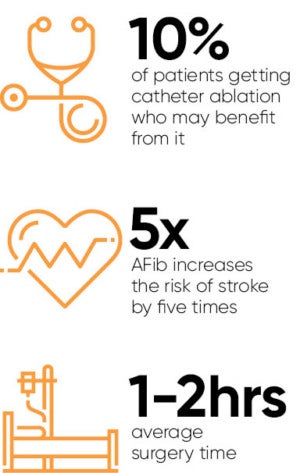 If being short of breath or feeling your heart flutter is a familiar sensation, you may be at a higher risk of stroke.
If being short of breath or feeling your heart flutter is a familiar sensation, you may be at a higher risk of stroke.
The symptoms could be caused by atrial fibrillation (AFib) – a type of irregular heartbeat – which is one of the prime factors leading to a stroke.
AFib is caused by irregular electrical impulses coming from the pulmonary veins, which disrupt the natural rhythm and beating of the heart.
More than one million people in the UK have AFib, but the symptoms and treatment pathways are not widely understood.
AFib increases the risk of stroke by five times as the abnormal rhythms can send the heart rate up from a normal level of 60 to 100 beats per minute to 140. This puts the heart under stress, and it struggles to relax and empty properly before filling with blood again, which can allow blood to pool and then form clots. It is these clots which can travel through the bloodstream to the brain, causing a stroke.
Early treatment is essential and experts advocate greater awareness of the symptoms, which include palpitations, chest pain or fatigue, and for effective treatments to be more widely used.
Physicians have developed an arsenal of therapies to combat AFib-related stroke, ranging from blood-thinners to pacemakers and procedures such as ablation therapy that correct abnormal rhythms. But there is concern they are not being fully deployed across health systems.
Research has indicated that catheter ablation – a minimally invasive technique endorsed by the European Society of Cardiology – is only being used in around 10 per cent of patients who may benefit from it.
Ablation uses radiofrequency waves to target minute areas of the heart which are triggering the potentially dangerous rhythms. The malfunctioning electrical impulses are isolated and blocked before they can disrupt the heart’s normal rhythm.
The surgery takes on average one to two hours and patients normally leave hospital the following day.
“It is incredible to see how the advancements in technology have improved quality of life for millions of patients worldwide,” says Mark Dickinson, vice president of global strategic marketing at Biosense Webster, which is a leading developer of AFib surgery procedures and instruments. “The challenge we have is that many more millions of patients are unaware of this option and so not enough patients come through the system to get the treatment they need.
“But the more you leave AFib untreated, the more entrenched it becomes and the harder it is to treat further down the line. The guidelines in Europe and the United States are that if a patient fails one drug therapy, they should be referred to an electrophysiologist, a specialist who can assess if other drugs or ablation are needed.”
Research in Italy, which is believed to be indicative of healthcare outcomes across Europe and the US, suggests some patients have been through seven or eight drug regimes before being considered for an ablation procedure.
Anti-coagulation drugs can dramatically reduce the risk of AFib and AFib-related stroke, but they are not effective for all patients, which is where ablation and other procedures have better outcomes.
The challenge we have is that many more millions of patients are unaware of this option and so not enough patients come through the system to get the treatment they need
In 2012, the ablation procedure’s efficacy was reinforced in a consensus statement endorsed by the European Heart Rhythm Association, a registered branch of the European Society of Cardiology, and the European Cardiac Arrhythmia Society, which stated: “As demonstrated in a large number of published studies, the primary clinical benefit from catheter ablation is an improvement in quality of life resulting from elimination of symptoms such as palpitations, fatigue or effort intolerance.”
Pilot Tim Knutson, 47, is evidence of the success of ablation as he was devastated after being grounded by his AFib. “My experience was phenomenal because afterwards I was legal to fly again. I was very happy and the very next day I was up in the sky,” he says.
His wife, Dawn, adds: “You take life for granted and what we learnt from this was that every day is important and tragedy can hit any time.”
Biosense Webster believes its procedure can help many more people like the Knutsons. “The challenge is that more education is needed among clinicians and the public so these proven procedures can be utilised,” says Mr Dickinson. “The risks to patients and health economies are heightened by treatment delays.
“Patients suffering with symptoms that reduce their quality of life are a massively underserved population. More education is needed so the public are aware of the risks of AFib and to understand their treatment options. The pathways to treatments with good outcomes exist, but we don’t see them utilised often enough in the NHS and other healthcare systems.”
Visit getsmartaboutafib.com and biosensewebster.com to learn more

